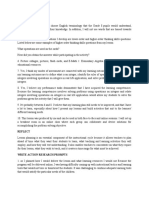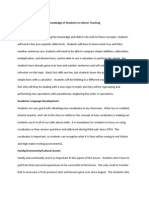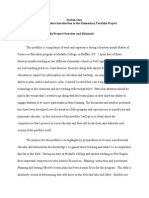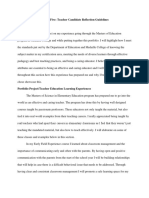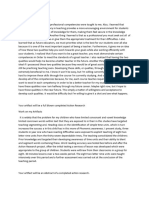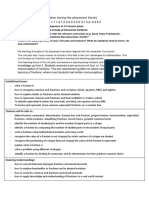Standard 4 Artifact Reflection
Standard 4 Artifact Reflection
Uploaded by
api-238727715Copyright:
Available Formats
Standard 4 Artifact Reflection
Standard 4 Artifact Reflection
Uploaded by
api-238727715Original Title
Copyright
Available Formats
Share this document
Did you find this document useful?
Is this content inappropriate?
Copyright:
Available Formats
Standard 4 Artifact Reflection
Standard 4 Artifact Reflection
Uploaded by
api-238727715Copyright:
Available Formats
Artifact Reflection Artifact Title: Neal Wilkins Lesson Plan Date Completed: October 17, 2013 Artifact Description
In the fall of 2013, I completed a lesson plan for Mr. Fleschs kindergarten class at Neal Wilkins Elementary School in Platteville, Wisconsin. The lesson plan contains a general description of the lesson, information about students and their learning needs, teaching standards, objectives, procedures, and assessments of the students. Wisconsin Teaching Standard Alignment This artifact addresses Wisconsin Teaching Standard 4: The teacher understands and uses a variety of instructional strategies, including the use of technology, to encourage children's development of critical thinking, problem solving, and performance skills. This artifact best aligns with Standard 4 because it is a successfully designed lesson plan that uses different forms of instruction for problem solving in Mathematics. While writing this lesson plan, I learned a how to create the different levels of instructions, used technology that I was not fully familiar with, and created objectives, procedures, and assessments for the students to successfully complete the lesson. This lesson also applies to the previous knowledge of what the students already understood about the subject matter because it is what they were already learning in class when I gave the lesson and the goal was to teach them about basic mathematical skills. An example of my understanding of proper instruction and construction of lesson planning is the Math lesson plan I created for Mr. Fleschs kindergarten class . At the time, we were covering basic addition problems using pictures as manipulatives to help solve math problems. This particular lesson included the problem involving cutting out the correct number of pieces of pie and placing them in the correct side of the equation based on what the problem was asking. The students then had to write the numbers out for the equation under the pictures and then solve the problem. There were different instructional strategies I used for students to be successful in this lesson. For visual learners, I originally had planned to use the SMART Board but it was not working that day so I had to compensate and use overhead to show math examples to help the students review some basic math skills. I then used cutout manipulatives for students who learn hands-on. I was also repetitive with my instructions to help students who are aural learners. This lesson allowed me to teach using different strategies for instructions to help students develop different ways of thinking to complete problem solving at multiple levels of performance. With this experience, I have gained a higher level of achievement in this standard. It has taught me how to use instructional strategies to provide students with the ability to develop problem solving skills to increase performance levels and develop critical thinking.
Artifact Reflection UW Platteville School of Education Knowledge, Skill, Disposition Statement Alignment This artifact best aligns with KSD1.a. : Demonstrates Knowledge of Content and Pedagogy The candidate displays extensive content knowledge of his/her subject areas and demonstrates a continuing search for new content knowledge, resources, and best instructional practices, while understanding student diversity and student misconceptions and misunderstandings as key to the teaching process. This artifact addresses KSD1.a. because it allowed me to explore my understanding of creating a proper lesson plan and take the previous knowledge I had about the content that I was going to teach and use it to create a more reliable and successful lesson plan. Writing this lesson plan also allowed me to demonstrate my ability of using my surrounding resources such as the overhead, different teaching strategies, and the ability to use instructional methods. After this experience, I have gained a higher sense of proficiency because I had the chance to demonstrate how to use this lesson plan in order to create learning and instruction in the classroom. I was however familiar with this experience because I have had previous experience with creating simplified lesson plans to help form a better learning environment. Secondary KSDs: KSD3.d. Provides Feedback to Students KS1.d. Demonstrates Knowledge of Resources KSD1.c: Selects Instructional Goals Reflection What I learned about teaching/learning from this experience: From this experience, I have learned how to create an effective lesson plan. I have learned that with teaching, every lesson plan has to be effective and fun for the student to engage in the learning you are trying to provide. With this lesson plan, I learned how to create different levels of instruction, compensate for technology malfunction, and develop a sense of critical thinking among the students. Creating this lesson plan also allowed me as to how to learn as a teacher, but how to learn as a student as well. What I learned about myself as a prospective educator as a result of this experience: As a result of this experience, I have learned that time management is very important in lesson planning and how I must apply it to each subject in the curriculum. I have also learned that it is important for teachers to connect the learning styles of each student to gain perspective and ideas to help increase their own learning experience as the teacher so I can make the students more successful. As an educator, it is important to keep students on task at all times so that they can fully obtain the information given so that it will help them progress through this year and the next.
You might also like
- Steiner - A Philosophy of FreedomDocument304 pagesSteiner - A Philosophy of FreedomEze Iván Duarte86% (7)
- FEAPs PortfolioDocument3 pagesFEAPs Portfoliochelsea2310No ratings yet
- FEAPs PortfolioDocument2 pagesFEAPs Portfoliochelsea2310No ratings yet
- Danielsons Framework For TeachingDocument21 pagesDanielsons Framework For Teachingapi-302150632No ratings yet
- Professional Practice 3 JustificationDocument2 pagesProfessional Practice 3 Justificationapi-555558629No ratings yet
- Kracauer - The Challenge of Qualitative Content AnalysisDocument12 pagesKracauer - The Challenge of Qualitative Content Analysiszero_delight100% (1)
- Physics For Students of PhysiotherapyDocument4 pagesPhysics For Students of PhysiotherapyAldo Xavier100% (1)
- Teaching Learning N Assessing Science 5 12Document272 pagesTeaching Learning N Assessing Science 5 12rosafuenfloNo ratings yet
- Goal Setting Evaluation and Rubric USF Elementary EducationDocument4 pagesGoal Setting Evaluation and Rubric USF Elementary Educationchelsea2310No ratings yet
- Reflection Paper AstDocument6 pagesReflection Paper Astapi-534848602No ratings yet
- Numeracy For All Success StoriesDocument24 pagesNumeracy For All Success StoriestsuiakNo ratings yet
- FS2-LearningEpisode-8 FINALDocument6 pagesFS2-LearningEpisode-8 FINALTrendy PorlageNo ratings yet
- FS 2 Episode 10Document5 pagesFS 2 Episode 10karen marie dela pasionNo ratings yet
- Lesson Plan RequirementDocument4 pagesLesson Plan RequirementCharmie EscuadroNo ratings yet
- RationaleDocument4 pagesRationaleapi-352784801No ratings yet
- Planning CommentaryDocument7 pagesPlanning Commentarydarnelllogan8No ratings yet
- 11 Reflection Learner - S OutputDocument15 pages11 Reflection Learner - S OutputhailaNo ratings yet
- Finalstandard 7Document2 pagesFinalstandard 7api-263392674No ratings yet
- Ochoa Alice Lesson Analysis ThreeDocument3 pagesOchoa Alice Lesson Analysis Threeapi-643960803No ratings yet
- Strengths and WeaknessesDocument12 pagesStrengths and Weaknessesapi-659481757No ratings yet
- Section One: Teacher Candidate Introduction To The Elementary Portfolio ProjectDocument8 pagesSection One: Teacher Candidate Introduction To The Elementary Portfolio Projectapi-291430586No ratings yet
- Arkhipova Kristina Final ReflectionDocument5 pagesArkhipova Kristina Final Reflectionapi-339339152No ratings yet
- Section FiveDocument6 pagesSection Fiveapi-532276589No ratings yet
- Evaluation of English Lesson 1Document2 pagesEvaluation of English Lesson 1api-523656984No ratings yet
- Arp ReflectionDocument3 pagesArp Reflectionapi-317806307No ratings yet
- artifactsfs2WPS OfficeDocument5 pagesartifactsfs2WPS OfficejuliopajacNo ratings yet
- Reflectionf For FsDocument18 pagesReflectionf For Fssaymanronna01No ratings yet
- LP 3 - SaDocument6 pagesLP 3 - Saapi-332343835No ratings yet
- Summarization of Insights On Module 9Document6 pagesSummarization of Insights On Module 9Rachelle MallariNo ratings yet
- Domain: Skills Dimensions: Skill in Planning, Teaching, Assessing, & Developing Caring Learning EnvironmentsDocument4 pagesDomain: Skills Dimensions: Skill in Planning, Teaching, Assessing, & Developing Caring Learning EnvironmentsLillian WhelanNo ratings yet
- Danielle Ruff Intasc Standard 8: Instructional Strategies: What Is This Artifact?Document3 pagesDanielle Ruff Intasc Standard 8: Instructional Strategies: What Is This Artifact?Danielle ruffNo ratings yet
- Unit Plan Rationale: BackgroundDocument6 pagesUnit Plan Rationale: Backgroundapi-352784801No ratings yet
- Selection Criteria RevisedDocument7 pagesSelection Criteria Revisedapi-297454133No ratings yet
- Literacy Plan RationaleDocument3 pagesLiteracy Plan Rationaleapi-352784801100% (1)
- Action PlanDocument3 pagesAction Planapi-302250677No ratings yet
- I Hear and I Forget, I See and I Remember and I Do and I UnderstandDocument36 pagesI Hear and I Forget, I See and I Remember and I Do and I UnderstandHazel Grace Tasarra-VargasNo ratings yet
- VI. Reflection and Self-Evaluation-GoalsDocument5 pagesVI. Reflection and Self-Evaluation-Goalsapi-295128690No ratings yet
- LESSON 7 - Preparing For Quality TeachingDocument55 pagesLESSON 7 - Preparing For Quality Teachingjenny Jalayajay100% (2)
- Teacher Professional Growth PlanDocument2 pagesTeacher Professional Growth Planapi-268987912No ratings yet
- Edts 234 Journal SynthesisDocument3 pagesEdts 234 Journal Synthesisapi-314845964No ratings yet
- Acei PortfolioDocument18 pagesAcei Portfolioapi-264661011No ratings yet
- Goals For Ps IIIDocument4 pagesGoals For Ps IIIapi-239090309No ratings yet
- Fatima Teaching Filosofy LearningDocument12 pagesFatima Teaching Filosofy LearningFatima Duran VasquezNo ratings yet
- Tpa Activity 3Document3 pagesTpa Activity 3api-480040176No ratings yet
- FS 2 Episode 10Document6 pagesFS 2 Episode 10Karen Mae Castro100% (1)
- Unit 9 - Measurement Lesson Plan 3Document5 pagesUnit 9 - Measurement Lesson Plan 3api-607301023No ratings yet
- 03 CompleteDocument6 pages03 Completeapi-241409424No ratings yet
- Teaching of History: Lesson PlanDocument9 pagesTeaching of History: Lesson PlanAria ImadNo ratings yet
- Standard 10 ReflectionDocument2 pagesStandard 10 Reflectionapi-340244643No ratings yet
- PostobservationreflectionDocument3 pagesPostobservationreflectionapi-300691216No ratings yet
- ITL 520 Learning Map Assignment - Timothy GeyerDocument12 pagesITL 520 Learning Map Assignment - Timothy GeyerTimothy GeyerNo ratings yet
- What Teaching Learning Technique Was by The Teacher?Document6 pagesWhat Teaching Learning Technique Was by The Teacher?rujean romy p guisandoNo ratings yet
- Reflection and Self-EvaluationDocument5 pagesReflection and Self-Evaluationapi-241287310No ratings yet
- Sample Question For Applying An Mathematics TeacherDocument8 pagesSample Question For Applying An Mathematics TeacherGerald Jariolne JamesolaminNo ratings yet
- Reflections For Standard 1 1.A.3 Rigorous Standard-Based Unit DesignDocument3 pagesReflections For Standard 1 1.A.3 Rigorous Standard-Based Unit Designapi-317761911No ratings yet
- Iowa Teaching Standard #6 - Demonstrates Competence in Classroom ManagementDocument1 pageIowa Teaching Standard #6 - Demonstrates Competence in Classroom Managementapi-297195256No ratings yet
- Section 5 PortfolioDocument9 pagesSection 5 Portfolioapi-517294534No ratings yet
- Intern: Mariam Aboudib Grade/Subject: 9, Biology: Self-EvaluationDocument7 pagesIntern: Mariam Aboudib Grade/Subject: 9, Biology: Self-Evaluationapi-354063119No ratings yet
- Project 6: Action Research Project On Problem-Based Learning in MathDocument11 pagesProject 6: Action Research Project On Problem-Based Learning in Mathdayle02No ratings yet
- Ly0113 01Document4 pagesLy0113 01wilmot dropperNo ratings yet
- Learning & Study Guide for Adult Students: Teacher's ManualFrom EverandLearning & Study Guide for Adult Students: Teacher's ManualNo ratings yet
- Not Saussure A Critique of Post Saussurean Literary TheoryDocument293 pagesNot Saussure A Critique of Post Saussurean Literary TheoryGuldre1okk100% (1)
- The International Journal of LexicographyDocument15 pagesThe International Journal of Lexicographyapi-6708709No ratings yet
- The Hypothetico-Deductive Method of Scientific Research.: IntroductionDocument4 pagesThe Hypothetico-Deductive Method of Scientific Research.: Introductiontrendsetters80No ratings yet
- Assignment On Article ReviewDocument5 pagesAssignment On Article ReviewPrafull ShreemodNo ratings yet
- Working Defining Level C2Document6 pagesWorking Defining Level C2Sarah MalloNo ratings yet
- Nine Roles White PaperDocument8 pagesNine Roles White Papertempduc177No ratings yet
- The Concept of Al Faruqi and Al AttasDocument9 pagesThe Concept of Al Faruqi and Al AttashasimvnNo ratings yet
- Practice Exercise For ValidityDocument5 pagesPractice Exercise For Validitytnnt98No ratings yet
- Math-M 3112 Teaching Math in The Primary GradesDocument3 pagesMath-M 3112 Teaching Math in The Primary GradesChristine Joy Lara83% (6)
- Edu 5109 - Lesson Plan 3 - Formal CommandsDocument6 pagesEdu 5109 - Lesson Plan 3 - Formal Commandsapi-289975804No ratings yet
- Nature & Importance Of: Lesson PlanningDocument20 pagesNature & Importance Of: Lesson PlanningleetolbeanNo ratings yet
- What Are Mathematical Problems - Emam Hoosain - 8 Pág - HoosainDocument8 pagesWhat Are Mathematical Problems - Emam Hoosain - 8 Pág - HoosainElliotNo ratings yet
- Caro J Tel311 Direct Instruction Lesson Plan Template 1Document3 pagesCaro J Tel311 Direct Instruction Lesson Plan Template 1api-533524107No ratings yet
- GIL0669 PersonalSuccessMade BonusPDF-2Document76 pagesGIL0669 PersonalSuccessMade BonusPDF-2Amir KhanNo ratings yet
- Boundary ManipulationDocument3 pagesBoundary ManipulationSunčica NisamNo ratings yet
- The Implementation of Tauhidic Approach 2500Document11 pagesThe Implementation of Tauhidic Approach 2500Jamil AbdullahNo ratings yet
- PT 2 - Synthesis Reaction PaperDocument4 pagesPT 2 - Synthesis Reaction Paperapi-353957387100% (1)
- UntitledDocument11 pagesUntitledkamiNo ratings yet
- Niklas Luhmann - Contingency, Risk, Trust and ReflectionDocument8 pagesNiklas Luhmann - Contingency, Risk, Trust and ReflectionAlicja SkoczylasNo ratings yet
- Lesson Study Lesson PlanDocument7 pagesLesson Study Lesson Planapi-273732137No ratings yet
- Syllogisms in EducationDocument6 pagesSyllogisms in EducationJonathan AcuñaNo ratings yet
- Unit 1 NotesDocument3 pagesUnit 1 Notesapi-300762638No ratings yet
- Talal Asad - Anthropology and The Analysis of IdeologyDocument22 pagesTalal Asad - Anthropology and The Analysis of IdeologyAriana Hernandez100% (1)
- HIM 200 - Week 1 - Assignment 2 - Writing RubicDocument1 pageHIM 200 - Week 1 - Assignment 2 - Writing RubicCarol LigletNo ratings yet
- Tony Veale-Exploding The Creativity Myth - The Computational Foundations of Linguistic Creativity (2012) PDFDocument201 pagesTony Veale-Exploding The Creativity Myth - The Computational Foundations of Linguistic Creativity (2012) PDFCarmen Romero100% (1)
- Constructing Research Questions and Gap SpottingDocument12 pagesConstructing Research Questions and Gap SpottingIsnan Hari MardikaNo ratings yet












